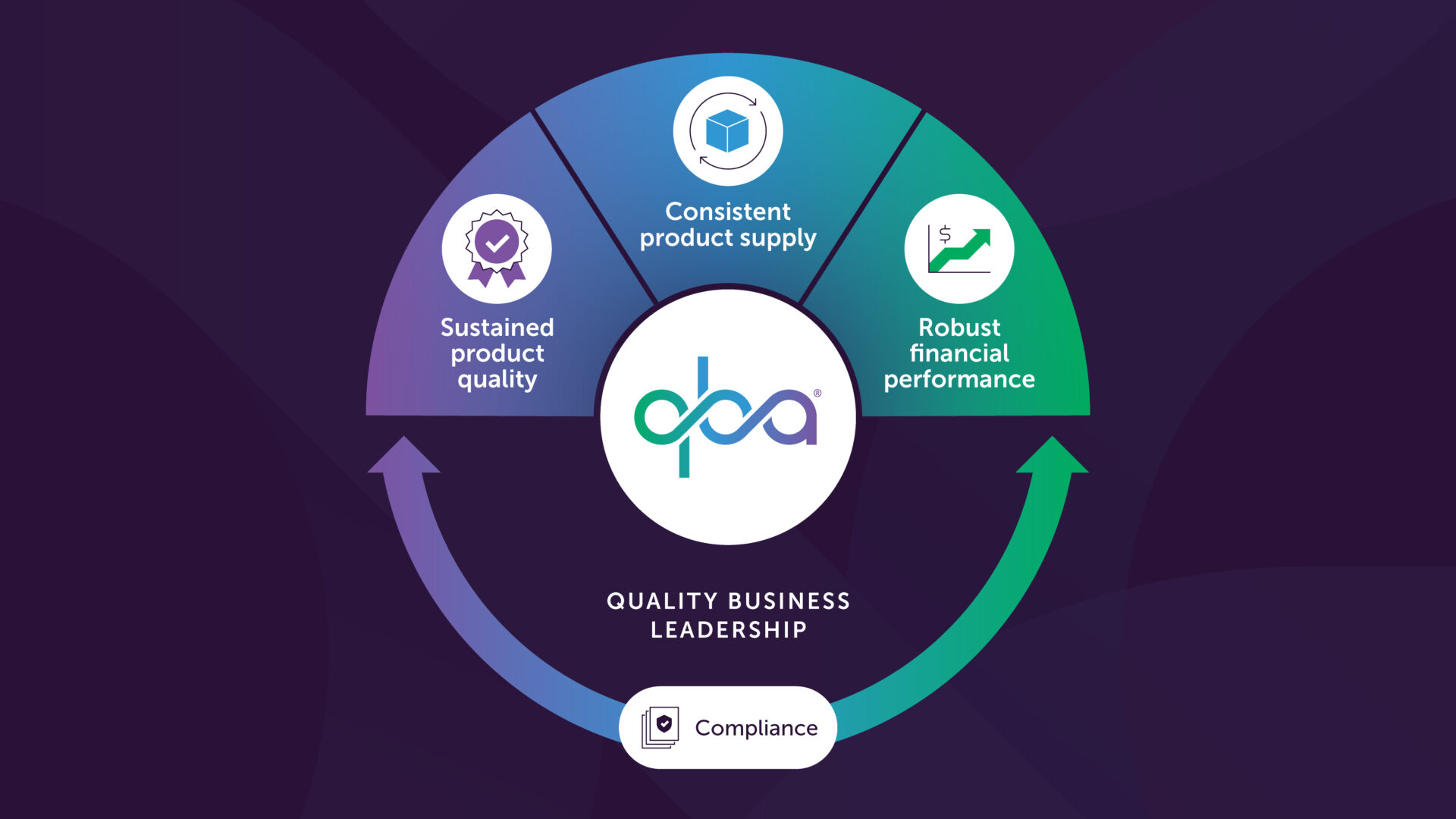Introduction
100 senior leaders from the pharmaceutical industry, academia and regulatory agencies gathered for the first time at Technological University Dublin, Ireland, on May 1st, 2024, to discuss Quality Business Leadership (QBL). The consensus by the attendees is that the Quality function needs to transition from traditional compliance focused Quality Management to QBL. The objective of this transition is to integrate the Quality function into the overall company business enabling quality become a business advantage, and taking the lead for more continual improvement activities, thus reducing the likelihood of drug shortages. Keynote perspectives were presented by HPRA CEO Lorraine Nolan and former FDA acting commissioner Janet Woodcock. A QBL Manifesto – a call to action – was discussed at the summit and finalized shortly after.
The next practical steps towards implementing QBL in pharmaceutical companies include (1) education, with a TU Dublin accredited QBA Certification Program starting in September 2024, (2) engaging and educating senior leaders in the six traits of QBL (see below) which were presented at the summit (3) socializing the QBL Manifesto, and (4) planning a follow-on summit in 12 months or less. Transitioning to QBL is not trivial and requires a deliberate change of focus and behaviors.
Summary of the Summit
Below is a summary of the presentations and dialogue at the summit aligned to the six Quality Business Leadership traits:
- Lead the path to one global quality regulatory framework
- Visibly demonstrating responsibility for quality
- Engage employees to continuously improve quality
- Make risk-informed decisions that benefit patients
- Advocate that quality is owned by all through developing senior management partnerships
- Promoting quality as a value-driven financial value
Trait: ‘Lead the path to one global quality regulatory framework’
HPRA CEO Lorraine Nolan in her keynote remarks shared perspectives on one of the six QBL trait, that of “Lead the path to one global quality regulatory framework”. Lorraine discussed the International Coalition of Medicines Regulatory Agencies (ICMRA) comprising the Heads of Agencies, vision for a global Pharmaceutical Quality Knowledge Management System (PQKMS) capability that works towards a single (‘worldwide’) submission, single assessment, and a single agreed Post Approval Change Management Protocol (PACMP). ICMRA is well into collaborative PAC and hybrid inspection pilots with select pharma companies. Lorraine, who is one of the leaders of the PQKMS pilot, shared that the regulators will measure success by a common vision, collaborative approach, reduced complexity, increased agility, and scalability.
It was exciting to see that the ICMRA PQKMS work demonstrates in practice that Heads of Regulatory Agencies have started down the path to one global regulatory framework. As a community of industry-based Quality leaders, we have an opportunity to do the same, i.e. work in the direction of harmonized or even standardized PACs and other regulatory submissions. Ambitious, but absolutely within reach if we follow the example of ICMRA.
Trait: ‘Visibly demonstrating responsibility for quality’
Janet Woodcock, former acting FDA Commissioner and Head of Operation Warp Speed, in her presentation with the title “Taking a Stand for Pharmaceutical Quality” spoke about the need for QBL in general, and in particular, one of the six traits “Visibly demonstrating responsibility for quality”. In her conclusion she encouraged the Quality leader community to address quality lapses, take united actions to get to the next level of QBL thus being able to make quality an essential business capability and competitive advantage for companies and the industry. She emphasized that “one of the central principles of quality is that it has to be owned by the people, not the regulators”.
After presenting a summary of the history of pharmaceutical quality, Janet remarked that our industry continues to see serious quality lapses across the world, that the pharmaceutical industry is behind other industries with respect to low variability of manufacturing processes, and that Quality leaders are not seen as major corporate players. Many will remember Janet Woodcock’s 2002 vision for GMP for the 21st Century Manufacturing quote: “A maximally efficient, agile, flexible pharmaceutical manufacturing sector that reliably produces high quality drugs without extensive regulatory oversight.” In her presentation and the subsequent panel discussion, it was discussed that now, more than 20 years later, the vision has not become reality despite several efforts. Yet, the vision remains highly relevant. She strongly encouraged Quality leaders to try an approach other than what has been practiced the past two decades and instead take a collective stand for pharmaceutical quality. This includes developing common objectives for the industry with respect to quality, highlight the business value of quality, reverse reputational compliance or product availability issues, collectively advocate appropriate placement of quality within corporate structures, and train quality professionals in corporate leadership (i.e., in QBL).
Janet Woodcock’s presentation, her comments during the panel discussion that followed, and her afternoon panel moderation all were directed at Quality leaders, encouraging them to making an active decision and act together to transition to QBL as outlined in the six QBL traits. As Quality senior leaders it really is up to us to start the QBL journey.
Rick Friedman, FDA, also talked about this trait in his presentation titled “GMPs and the Quality-Business Synergy.” He spoke about the importance of ensuring a ‘state of control’ (ICH Q10 objective) and Senior Management’s accountability for quality, illustrated through failures in the form of several Warning Letters addressed directly to Executive Management. Rick Friedman summarized key points in a call to action including identifying and addressing current problems, ensuring strong quality management oversight, well-designed facilities, equipment and processes, and designing a PQS that proactively identifies and remediates issues. He finished his presentation with the words “commitment to quality assurance is essential for dependable drug supply”, thus directed both at senior Quality and company leadership to take on that leadership role in a proactive way.
Trait: ‘Engage employees to continuously improve quality’
“Engage employees to continuously improve quality” was the QBL trait discussed by New York Times bestselling author and change leadership expert Holger Rathgeber. He remarked that in a highly regulated GMP world where control, order, structure, procedures, and discipline is required, it is also important to lean into trust, agility, flexibility, judgment, and creativity. If we don’t find that balance in our organizations, there is a risk of complacency, bureaucracy, risk avoidance, mistrust, and boredom. Many have found themselves in that situation. In addition to discussing engagement of employees, Holger shared numerous examples that lead to the exact opposite, i.e. disengagement.
Trait: ‘Make risk-informed decisions that benefit patients’
Kevin O’Donnell, HPRA, discussed the QBL trait “Make risk-informed decisions that benefit patients”. Kevin O’Donnell is the rapporteur on the newly revised ICH Q9(R1), for which he provided an overview. In preparation for this meeting, he had asked several people about what they defined as good leadership – details are included in his slides. Kevin O’Donnell’s own thinking is that good quality leadership should ultimately result in an effective PQS, which led him to speak about what constitutes an effective PQS, as discussed in ICH Q9(R1), ICH Q10, ICH Q12 and in detail in the PIC/S paper on this subject.
By means of walking us through two case studies, Kevin shared ways which ICH Q9(R1) provides a framework for decision making when the company can demonstrate an effective PQS, and that poor Quality leadership can lead to an ineffective PQS.
Brendan Cuddy, Chair of the Inspectors Working Party at EMA, joined the morning speakers at the panel discussion and shared his views on the QBL topic. One of his remarks was that patients expect supply of medicines ‘like turning on a light switch’. Thus, when that is not the case it leads to reputational issues. He furthermore expressed that quality leaders need to take up this challenge.
Trait: ‘Advocate that quality is owned by all through developing senior management partnerships’
Paul O’Neill (Mallinckrodt), Maureen Larkin (Alexion/AZ), Tracy Walshe (Pfizer), and Cathal Elliott (Amgen), all are senior Operations leaders, discussed the QBL trait “advocate that quality is owned by all through developing senior management partnerships”. During their panel discussion they covered governance, people, and success measures amongst other things. They emphasized the importance of shared partnership between Operations and Quality leaders for strategic roadmaps, annual goals, co-sponsorship of key initiatives, and when defining and ensuring a desired quality culture. Regarding people, they talked about the benefit of cross-pollenating talent pipelines between Operations and Quality. Criteria for measuring success should be agreed upfront so that everyone knows about desired activities and behaviors.
Trait: ‘Promoting quality as a value-driven financial value’
Jane Wyatt (Alexion) and Anders Vinther (Quality Business Administration) both talked about the QBL trait “promoting quality as a value-driven financial value”. Jane Wyatt discussed driving value through proactive quality management and the benefit of using a cost of quality model to understand ‘where the money goes’. She shared case studies of cost avoidance, cost reduction and knowledge management to drive to better financial performance, much of which was supported by use of quality risk management.
Anders Vinther spoke about the importance of being able to articulate quality system activities in financial terms to (1) better understand where compliance and quality improvements also provide financial benefits for the company and (2) be better understood by the C-Suite that speaks the language of dollars and euros more so than compliance. He suggested that companies add a financial risk score (FRS = cost of correction multiplied by probability, divided by cost of prevention) in addition to the RPN number for each risk on the company risk register. He also showed examples of how the Quality System can be used to drive financial improvements that create more value for the company. He discussed one of Deming’s quotes that says “Improve quality & decreased cost will follow” and continued by saying that if you reverse the order, i.e. decrease cost as the primary objective, quality might be at risk. Anders Vinther concluded his presentation by stating that “It is not better quality or financial performance. It is better quality that improves financial performance.”
Conclusion
Pat O’Mahony, Chair of IMVO and HIQA and former CEO of HPRA, summarized the day by shared thoughts about each of the 6 QBL traits and that they collectively provide an outline of what Quality leaders must master to become great QBL leaders.
At the summit a QUALITY BUSINESS LEADERSHIP MANIFESTO was also discussed. The attendees submitted close to 200 comments and after the summit the MANIFESTO was revised based on this input. The intent of the Manifesto is to create awareness about QBL and start a movement of change for the Quality Function to be fully integrated into the company business.
All presentations, the Manifesto, and the program are available at the link Quality Business Leadership Summit.
Now taking applications for Fall 2024
The Certificate in Quality Business Leadership application period is now open through August 16.
Apply Now


